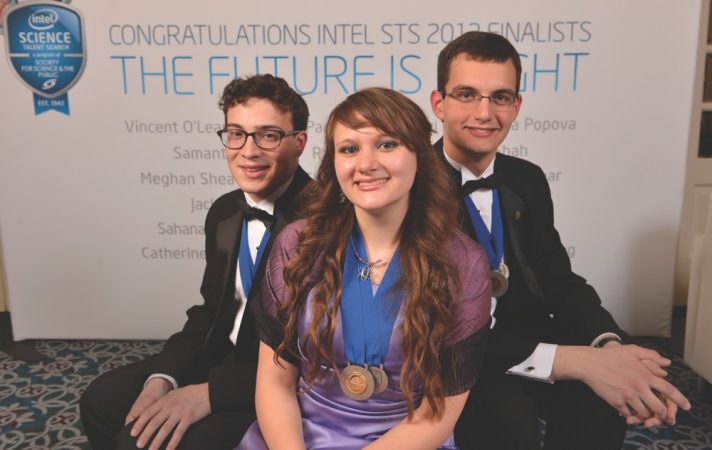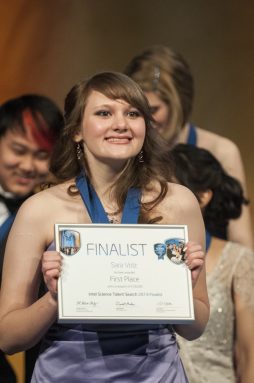Teens win big for their research
2013 Intel Science Talent Search awards teens for science projects
Share this:
- Share via email (Opens in new window) Email
- Click to share on Facebook (Opens in new window) Facebook
- Click to share on X (Opens in new window) X
- Click to share on Pinterest (Opens in new window) Pinterest
- Click to share on Reddit (Opens in new window) Reddit
- Share to Google Classroom (Opens in new window) Google Classroom
- Click to print (Opens in new window) Print

WASHINGTON, D.C. Sara Volz just became a $100,000 grand-prize winner for an experiment grown under her bed. On March 12, this 17-year-old snagged the top award at the 2013 Intel Science Talent Search (STS).
Volz is a bubbly student at Cheyenne Mountain High School, in Colorado Springs, Colo. She conducted an experiment that coaxed algae into boosting their production of oil for use in biofuel. Her winning research topped projects by 39 other finalists. In total, the competition received 1,712 entries from 42 states, the District of Columbia, Guam and two American schools overseas.
Volz conducted the experiment in her bedroom. She grew the algae in 40 glass flasks underneath her loft bed. Volz then used a herbicide that selectively killed the algae cells that dribbled out only tiny amounts of oil. She grew generation after generation of the algae. At the end, she was left with cells naturally producing high levels of oil.
Volz tended her algae garden almost every day. She checked it regularly for evaporation and kept it (and herself!) on strict light-dark cycles. “It’s basically like having a pet,” joked Volz.
Increasing the amount of oil that algae make presents a major challenge. But it is necessary for bringing down the cost of this renewable fuel. For now, fossil fuels are still cheaper.

Volz plans to attend the Massachusetts Institute of Technology this fall.
During the Intel STS awards gala, she gasped when her name was called. Volz then rushed across the stage at the National Building Museum. Decked out in a lavender satin dress, she laughed and smiled as blue and white balloons rained down on her and the competition’s other winners.
“SSP and Intel could not be prouder of the Intel Science Talent Search finalists of 2013,” said Elizabeth Marincola. She is president of the Society for Science & the Public (SSP) and publisher of Science News for Kids. “We eagerly look forward to following their contributions in the coming years in every field of human endeavor.”
At the ceremony, the Intel Foundation handed out $630,000 in prize money to the 40 finalists. SSP, which also publishes Science News, has run the competition since establishing it in 1942. Intel began sponsoring the competition in 2008.
Jonah Kallenbach, from Ambler, Penn., took home second place and $75,000. The 17-year-old figured out a way to better predict how different drugs latch onto proteins. Proteins are molecules that do most of the work in organisms. They also frequently are the target of medicines. Kallenbach’s work could give researchers a new way to design drugs that target specific areas along chains of proteins.
Third place and $50,000 went to Adam Joseph Bowman, 17, of Brentwood, Tenn. He spent several years designing, building and refining a plasma gun in his garage. He bought parts for his creation on eBay. Plasma is a gaseous state of matter in which electrons separate from the atom. Bowman also designed an inexpensive fiber optics system to follow the plasma’s movement. “I’ve always enjoyed building things,” he said.
Hannah Kerner Larson, 18, of Eugene, Ore., won fourth place and $40,000 for her project on a type of abstract mathematical structure called fusion categories. Peter Kraft, 17, of Munster, Ind., came in fifth, picking up $30,000/ He created 10 new molecules that could help improve how fuel cells store hydrogen. (Fuel cells produce electricity by combining a fuel — usually hydrogen — with oxygen.)
Sixth and seventh place winners Kensen Shi and Samuel Zbarsky each took home $25,000. Shi, 17, of College Station, Texas, designed an algorithm that helps robots navigate around obstacles. In his free time, Shi said, he likes to solve Rubik’s Cubes. Zbarsky, 17, of Rockville, Md., worked on a mathematics project that could help make computer networks more efficient.
Eighth, ninth and 10th places each came with $20,000 and went to Brittany Wenger, Akshay Padmanabha and Sahana Vasudevan, respectively. Wenger, 18, of Sarasota, Fla., created a computer software program to analyze tiny tissue samples taken from breast cancer patients. Padmanabha, 16, of Collierville, Tenn., devised a method for detecting seizures. (Seizures are a type of electrical storm in the brain.) Vasudevan, 16, of Palo Alto, Calif., worked on a math project to speed up computer algorithms.
The remaining 30 finalists each received $7,500. All 40 teens spent a week on an all-expenses paid trip to Washington. On March 10, these finalists presented their research to the public at the National Geographic Society.
The finalists elected Alexa Danzler to receive the Glenn T. Seaborg award. The distinction honors the memory of the late Nobel Prize–winning chemist and longtime Science Talent Search judge.
All 40 of the young finalists will change the world, said Jane Shaw, the former chairman of the Intel Corp. board. “It’s such an honor to help them launch their careers, right here this evening.”
Power Words
algorithm A group of rules or procedures for solving a problem in a series of steps. Algorithms are used in mathematics and in computer programs for figuring out solutions.
biofuel Diesel and other fuels produced from algae, plants or other living matter. Renewable biofuels are an alternative to nonrenewable fossil fuels.
plasma A gaseous state of matter in which electrons separate from the atom.
protein Molecules that do most of the work in organisms. Medicines frequently work by latching onto proteins.
seizure A sudden surge of electrical activity within the brain. Seizures are often a symptom of epilepsy.
selection In biology, a process in which environmental or genetic influences determine